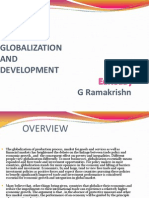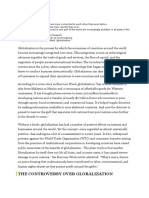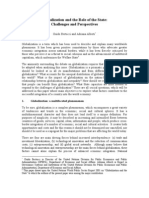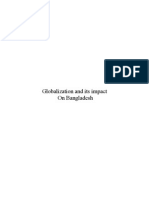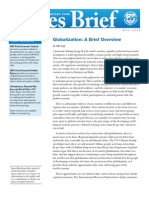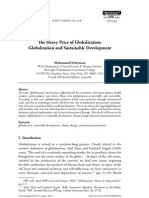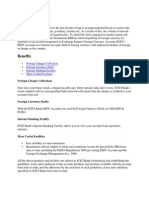SSRN 2303821
SSRN 2303821
Uploaded by
Ngân Trần Thị MinhCopyright:
Available Formats
SSRN 2303821
SSRN 2303821
Uploaded by
Ngân Trần Thị MinhOriginal Title
Copyright
Available Formats
Share this document
Did you find this document useful?
Is this content inappropriate?
Copyright:
Available Formats
SSRN 2303821
SSRN 2303821
Uploaded by
Ngân Trần Thị MinhCopyright:
Available Formats
‘Globalization
is a fact of life. But I believe we have underestimated its fragility’
were the words of Kofi Annan, seventh secretary general of United Nations. It has
come out to be even truer in the current climate. The Economist Intelligence Unit
(2009) suggests that the in the last quarter of 2008, some economies have shrunk at
annualized rates of over 10%. Shrinking international trade, both in terms of goods
and services has meant that the countries that were growing at a faster rate are also
the ones to be affected by it the most. These countries, generally the developing
economies face a greater threat and bigger challenges to overcome and this essay
outlines the key issues in the context of international trade for goods and services. It
explores the options for and against some of the key topics like protectionism that
includes trade and non-trade barriers, corruption, poverty, focus on services, and
South-South trade as these really are the key challenges amid immense growth in the
developing world.
A key area of debate here is protectionism. High tariffs and trade-distorting domestic
subsidies in the developed countries are likely to hinder future growth for net
exporting developing countries. In a paper submitted to WTO by nine major
developing countries (2005), it was alleged that many developed countries maintain
high tariffs, tariff peaks and tariff escalation on products of interest to developing
countries concerning world trade. Cuthbertson and Carmichael (2006) acknowledge
that while protection is high, it has changed its course. They give an example saying
that while average industrial tariffs in OECD countries have been reduced from 40
percent to 4 percent through multilateral agreements, non-tariff barriers such as
changes in domestic policy, voluntary export restraints have escalated beyond the
authority of international rules and agreements. They have grown to the point where
they now affect a substantial proportion of world trade in goods and services.
But it is not just the protection in developed countries that pose a danger for
developing countries, campaigns like ‘Buy local’ within the emerging economies are
also a challenge for themselves. The Economist (2009) reports that recently, Vietnam
increased import tariffs on dairy products; India has upped tariffs on some types of
steels and Indonesian government will soon introduce regulations that will penalize
four million officials if they do not buy locally produced goods. These inward
2
Electronic copy available at: https://ssrn.com/abstract=2303821
policies are inevitable for most of the developing countries in the short term but it is
the international trade in goods and services that suffer in the long term. For
example, in countries like Vietnam, Thailand and Malaysia, exports account for more
than fifty percent of the economy, and for more than one-third in Indonesia and
China. Retaliatory barriers can hit these countries hard. In such a situation, local
governments are torn between what they say in public about the evils of trade
barriers- and the desire to protect special interest, taxpayers and voters at home. But
although the world trade has grown rapidly, the WTO members have not been able to
adjust the maximum levels of tariffs and other barriers that they could maintain on
goods and services. Mattoo and Subarmanian (2009) still hold the view that trade has
grown throughout the globe because many governments have increasingly come to
believe that openness promotes long-term development. Many unilaterally have
liberalised their regulations on goods and services. According to them, the tariffs on
goods have declined from a worldwide average of over 25 percent in 1980 to less
than 10% today. Even though much of this liberalisation has taken place in the form
of regional agreements such as NAFTA, other critics may still argue that
protectionist measures are still favoured among the developed.
Traditionally, protectionist measures are favoured by some politicians who believe
that it is politically and commercially justified. On the contrary, Willet et al (1984)
believes that by consistently applying a protectionist strategy to preserve current
employment patterns in the face of competition (which frequently is from other
domestic rather than foreign sources) would rob the economy of its dynamism over
the long run and leave us all poorer. This raises another challenge for developing
countries in international trade in goods and services; poverty.
The current long wave of globalization, greater exchange of goods and services
beyond the borders confirms neoliberal economic theory. Wade (2007) from London
School of Economics agrees that more open economies are more prosperous and
people who resist further economic liberalization must be acting out of vested
interests. It can be seen that this evidence validates the rationale of the World Trade
Organisation, the World Bank, the IMF and many other multilateral economic
3
Electronic copy available at: https://ssrn.com/abstract=2303821
organisations. A statistical evidence form IMF (Thomas, 2009) indicates that the gap
between the real GDP growth in emerging markets and in rich countries widened
from nothing in 1991 to about five points in 2007 and predicts will stay at 5.3 points
in 2009. But according to Martin Ravallion (2009) of the World Bank, roughly one
person in six in emerging markets had raised themselves above the $2-a-day poverty
line in 2005, though they still got less than a $3-a-day. So, the challenge now as ever
is being able to eradicate or reduce the number of poor people in developing
countries. So, is the global economic meltdown helping?
The integration of the world economy is in retreat on almost every front. The
economic meltdown has popularized a new term: ‘Deglobalisation’ and anti-
capitalist people like Walden Bello are happy about it. Conversely, helping poorer
countries catch up has long been among the benefits claimed for increase in world
trade of goods and services. Globalisation means the global integration of the
movement of goods, services, capital and jobs. Each of these processes is now in
trouble. (The Economist, 2009) For example, air cargo traffic (responsible for over a
third of the value of the world’s traded goods) was down 23% in December from last
year. (International Air Transport Association, 2009) It can be seen that the impacts
of shrinking world trade are going to be dire for developing countries many of which
depend on commodities including variety of goods and agriculture-based exports.
When they suffer due to shrinking world demand and subsequently decrease in
traded goods; poverty line is likely to catch hold of a greater number of people.
As the world economies become more integrated, and while open trade of goods and
services bring benefits to developing countries in transition, embracing this openness
also brings new risks to the developing countries. On of the key risks developing
countries now face is ‘Corruption’. Wei (2001), a fellow at Harvard University’s
International Development Center indicates that corruption is a key challenge in the
process of globalization. According to him, it can hinder a country’s ability to absorb
benefits of increase in traded goods and services. It is likely to do this by reducing
the foreign direct investments, may make an emerging economy more vulnerable to a
currency crisis as evident from Asian Crisis of late nine-tees.
Weaker regulation of trade and domestic policy on corruption has resulted in
4
Electronic copy available at: https://ssrn.com/abstract=2303821
increased corruption but they are not the only causes. It is likely that globalization of
trade itself encourages the chances of corruption. A simple illustration can be made
through a petty observation of world’s corruption level chart. If seen from
international trade perspectives, the countries that are more prone to corruption
(affecting their national output or GDP resulting from export in goods and services)
are also big players on the world trade market. (Transparency International, 2008)
The governments in developing countries are trying to curb corruption by
introducing stringent laws and heftier penalties for those who turn their back on the
system but it can be hard. The challenge is to eradicate corruption from political and
judicial structures first and then from the public. While corruption is something to
avoid, developing countries need to embrace new channels for growth.
One such channel can be focusing on trade in services along with agriculture and
other goods. The export strategies of most developing economies focus on goods and
overlook the chances to diversify trade through services. This is a key challenge but
equally services provide the backbone for all trade. A report by International Trade
Forum (2005) indicated that national development plans often excluded the service
sector. As the global service markets grow and offer opportunities in off shoring,
professional and tourism, it can be argued that even commodity-exporting
developing countries depend on services. Quality education, finance, logistics and
telecom services make agricultural and manufacturing producers as well as services
companies competitive.
The answer to the question, ‘what is holding developing countries and their
businesses back?’ lies in the lack of vision and competence when it comes to
services. A research (World Bank, 2005) shows that they have capacity and export
potential in many services sectors. Services account for at least 50% of GDP in most
developing countries but it is still well below most of the developed countries. For
example, South Asian countries especially India has seen a great surge in foreign
businesses opening and expanding their existing service operations. India has
benefited from the IT boom and mini silicon valleys are opening up around the
cosmopolitan cities of Hyderabad, Bangalore and Mumbai. On the other hand, many
services still remain to be explored by many in the developing world.
5
Electronic copy available at: https://ssrn.com/abstract=2303821
Shahid Yosuf, a research manager at the World Bank (2001) indicated that
developing countries have tended to neglect services that accounted for a fifth of
total trade in 1999. This in numbers was about $1.3 trillion. He adds to this saying
that the developing countries continue to lose out these as their manufacturing sub-
sectors rely on the efficiency of services, e.g. marketing, advertising, consulting and
logistics to achieve higher export earnings and growth. It is to be noted however,
that trade in certain types of producer services has expanded faster than goods since
as acknowledged by the World Bank.
Still, the main challenge is lack of awareness. In ‘services’, which is a diverse and
fragmented sector, data is hard to capture and trade statistics are understated. (ITF,
2005) Many developing economies are already exporting services but small firms
may not know they are exporting when they do businesses with foreigners. It is thus
very likely that public officials in these countries may not be aware of the scope of
their own services economy. But it is not just the awareness, the report form
International Trade Forum also indicates the regulatory barriers that exists in services
in neighboring and regional markets as a key issue. These can hinder their ability to
establish offices in export markets of interests and their ability to reach clients
abroad. Nevertheless, building credibility abroad is another challenge. The intangible
nature of services means that developing countries often have to overcome the
negative perceptions in international markets. But the perception may change as the
countries of the South command more and more growth and technology that can
influence the whole world.
Developing countries are now exercising more power in terms of international trade.
In the course of Doha Round negotiations, they demonstrated that they could veto
over world trade rules. The possibility of this continuing may seem uncertain and
thus brings the age-old challenge of ‘conflicts of interests’ among the countries of
South. Martin Walker (2008), from World Policy Institute, indicates that there are
clear signs of divergent interests among the developing countries (he refers to it as
South) that are likely to percent them from exercising their collective weight. An
example can be of the oil exporters of Middle East, Latin America, and Africa who
6
Electronic copy available at: https://ssrn.com/abstract=2303821
have an interest in high-energy prices than China or India, who would prefer cheaper
energy.
According to the United Nations conference on trade and development (2009) there
is still a great room for trade in goods and services among developing countries. The
promotion of South-South trade remains a desirable objective for a variety of
reasons. Firstly, the sluggish growth in developed countries and their continued trade
barriers against products of export interests to developing countries. Secondly, the
size of the rapidly growing Asian economies reduces the need for developing
countries to seek developed-country markets in order to benefit from the economies
of scale. Finally, if developing countries continue to be dependent on the developed
country markets, they are exposing themselves to possible pressure to undertake
unwanted commitments. It is important for developing countries to have an access to
developed country markets, as it is clearly a key element in developing countries’
productivity growth. But this is only part of the story.
Trade between developing countries is also vital. The research undertaken taken by
OECD (2006) indicates that if developing countries want to reap the maximum
benefits from multilateral trade liberalisation in goods and services, they too need to
open up their markets and boost trade among themselves. But it does remain to be
seen at a large scale. The research indicates that the tariff barriers affecting South-
South trade are still much higher than those affecting other trade, at an average
11.1% compared with 4.3% for North-North trade as shown in the figure below.
OECD does, however suggest that individual tariff rates vary widely across the
South, and the poorest countries tend to be those with the highest tariffs. Protection
levels are higher where the exporters’ income level falls. This points to the fact that
poorest countries tend to face the highest form of protectionism.
Electronic copy available at: https://ssrn.com/abstract=2303821
As a group, developing countries are likely to gain more from multilateral tariff
liberalisation than industrial countries. This can be proved in terms of shares of gains
in national incomes. But these gains depend significantly on the extent to which
developing countries are willing to open up their markets. For example, if trade in
services is liberalised, it will have a good effect on goods exports through cheaper
transport, communication and financial infrastructure.
When Kofi Annan said that people have underestimated globalisation’s fragility;; he
was probably referring to the continuum of challenges that the countries were to face
ahead. The essay shows that developing countries already have a greater influence on
world trade in goods and services than ever before. They face tough challenges and
while some of them are inherent and in their control (corruption and more focus on
services), others come outside their own domain (protectionism in developed
countries). Poverty is a challenge that can be controlled through equal distribution of
exporters’ earnings in the developing countries but most importantly, the key point is
that they should open themselves to each other first. If the developing countries do
manage to overcome these challenges, the balance gains from trade policy reforms
will continue shifting in favour of South-South trade, making the case for low and
middle-income developing countries even stronger. On the whole, developing
countries may have to revitalise their growth channels in both goods and services.
Electronic copy available at: https://ssrn.com/abstract=2303821
References
Carmichael, B. & Cuthbertson, S. (2006) Developing Countries and the WTO.
[Online] Available at:
http://www.tasmantransparencygroup.com/downloads/DEVELOPING%20COUNTR
IES%20AND%20THE%20WTO.pdf [Accessed 14 March 2009]
International Trade Forum. 2005. Promoting Exports of Services: How to Make it
Happen. [Online] Available at:
http://www.tradeforum.org/news/fullstory.php/aid/869/Promoting_Exports_of_Servi
ces:_How_to_Make_It_Happen.html [Accessed 26 March 2009]
International Trade Forum. 2003. Market Access Barriers: A Growing Issue for
Developing Country Exporters?. [Online] Available at:
http://www.tradeforum.org/news/fullstory.php/aid/552/Market_Access_Barriers:_A_
Growing_Issue_for_Developing_Country_Exporters_.html [Accessed 26 March
2009]
Mattoo, A & Subramanian, A. (2009) From Doha to the Next Bretton Woods: A
New Multilateral Agenda. Foreign Affairs, [Online]. 88(1). Abstract from Business
Source Complete database.
Available at:
http://search.ebscohost.com/login.aspx?direct=true&db=bth&AN=35634215&site=b
si-live [Accessed 01 March 2009]
OECD (2006), Dihel, N., Kowalski, P., Shepherd, B. (2006), “South-South Goods
and Services Trade”, in Douglas Lippoldt (ed.), Trading Up: Economic
Perspectives on Development Issues in the Multilateral Trading System, OECD.
Paris.
Qureshi, Z. (1996) Globalisation: New Opportunities, Tough Challenges. Finance &
Development. [Online] Available at:
Electronic copy available at: https://ssrn.com/abstract=2303821
http://www.worldbank.org/fandd/english/0396/articles/050396.htm [Accessed 16
March 2009]
The Economist Intelligence Unit. 2009. Country Analysis & Forecasts. [Online]
Available at: http://countryanalysis.eiu.com/country_reports [Accessed 05 March
2009]
The Economist. 2009. Globalisation: Turning their backs on the world. [online]
Available at:
http://www.economist.com/world/international/displaystory.cfm?story_id=13145370
[Accessed at 19 February 2009]
The Economist. 2009. Falling World Trade: Going Under. [Online] Available at:
http://www.economist.com/finance/displaystory.cfm?story_id=13355727 [Accessed
24 March 2009]
The Economist. 2009. Shrinking World Trade. February 390(8621), pp.67-69
Thomas, H.A., 2009. Financial Crises and Emerging Market Trade. [Online]
Available at: http://www.imf.org/external/pubs/cat/longres.cfm?sk=22773.0
[Accessed 25 March 2009]
Transparency International. 2008. 2008 Corruption Preceptions Index Table.
[Online] Available at:
http://www.transparency.org/news_room/in_focus/2008/cpi2008/cpi_2008_table
[Accessed 25 March 2009]
United Nations Conference on Trade and Development. 2005. South-South trade.
[online] Available at:
http://www.unctad.org/Templates/Page.asp?intItemID=3821&lang=1 [Accessed 01
March 2009]
10
Electronic copy available at: https://ssrn.com/abstract=2303821
United Nations Chronicle Online Edition. 2006. Kofi Annan: Looking Back on a
Remarkable Decade. [Online] Available at:
http://www.un.org/Pubs/chronicle/2006/issue4/0406p09.htm [Accessed 01 March
2009]
Wade, H.R., 2007. Is Globalisation Reducing Poverty and Inequality?. World
Development. 32(1) pp. 156-158
Walker, M., (2008) The Southern Superman. World Policy Journal. [Online] 25(4)
pp. 133-143. Abstract from MIT Press Journal databse.
Available at: http://www.mitpressjournals.org/doi/abs/10.1162/wopj.2009.25.4.133
[Accessed 26 March 2009]
Wei, J.S., (2001) Corruption and Globalisation. [Online] Available at:
http://www.ciaonet.org/pbei/bi/wes01/wes01.pdf [Accessed 21 March 2009]
World Trade Organisation. 2005. Reclaiming Development in the WTO Doha
Development Round. [Online] Available at:
http://www.choike.org/nuevo_eng/informes/3643.html [Accessed 10 March 2009]
World Trade Organisation. 2008. World Trade Report 2008: Trade in a Globalised
World. [Online] Available at:
www.wto.org/english/res_e/booksp_e/anrep_e/world_trade_report08_e.pdf
[Accessed 10 March 2009]
Yosuf, S. (2001) Globalisation and the Chellenge for Developing Countries. World
Bank Policy Research Working Paper No. 2618. [Online] Abstract from Social
Science Research Network database.
Available at: http://papers.ssrn.com/sol3/papers.cfm?abstract_id=632686
[Accessed 27 March 2009]
11
Electronic copy available at: https://ssrn.com/abstract=2303821
Bibliography
Bjorn, L. (2009) Help the Poor with Free Trade. Forbes; 3/16/2009 [Online], 183(5)
pp. 24-25. Available at:
http://search.ebscohost.com/login.aspx?direct=true&db=bth&AN=36792851&site=b
si-live [Accessed 23 March 2009]
Boltho, Andrea 1999. The Assessment: The Twentieth Century – Achievements,
Failures, Lessons. Oxford Review of Economic Policy, Vol. 15, No. 4.
Chakrabarti, Arik, 2000. Do Nations Who Trade More Have a More Unequal Income
Distribution? University of Wisconsin at Milwaukee.
Freund, Caroline, Simeon Djankov, 2000. The Politics of Trade Liberalization: An
Empirical Investigation. Mimeo. World Bank.
12
Electronic copy available at: https://ssrn.com/abstract=2303821
You might also like
- Globalization ReflectionDocument3 pagesGlobalization ReflectionlapNo ratings yet
- Globalization AND Development G RamakrishnDocument12 pagesGlobalization AND Development G RamakrishnRakesh Sandhal100% (1)
- Module 1 Module in International EconomicsDocument18 pagesModule 1 Module in International EconomicsMar Armand RabalNo ratings yet
- Free Trade: A Comprehensive Strategy in A Globalized WorldDocument7 pagesFree Trade: A Comprehensive Strategy in A Globalized WorldIAEME PublicationNo ratings yet
- Jimmy Truong Mod2Document8 pagesJimmy Truong Mod2jimmyytruongNo ratings yet
- Barriers and Drivers of GlobalisationDocument7 pagesBarriers and Drivers of GlobalisationViknesh KumananNo ratings yet
- Definition of GlobalizationDocument6 pagesDefinition of GlobalizationShreya ChowdhuryNo ratings yet
- Bulletin 09 July 20Document10 pagesBulletin 09 July 20rodobejaranoNo ratings yet
- The Structure of GlobalizationDocument16 pagesThe Structure of GlobalizationRoselle Joy VelascoNo ratings yet
- Globalization and The New Sustainability FrameworkDocument9 pagesGlobalization and The New Sustainability FrameworkMirza ŠrndićNo ratings yet
- The Pros and Cons of Globalization: Start Download - View PDFDocument5 pagesThe Pros and Cons of Globalization: Start Download - View PDFClaudiu RaicaNo ratings yet
- Un Pan 006225globalization and The Role of The State: Challenges and PerspectivesDocument26 pagesUn Pan 006225globalization and The Role of The State: Challenges and PerspectivesMaha IsmailNo ratings yet
- Trade Barriers: Academy of Taiwan Business Management Review January 2010Document23 pagesTrade Barriers: Academy of Taiwan Business Management Review January 2010amisha pahwaNo ratings yet
- Int4801 Assignment 1 PDFDocument11 pagesInt4801 Assignment 1 PDFDevaki YashodaNo ratings yet
- Unit 2 - The Structures of GlobalizationDocument8 pagesUnit 2 - The Structures of GlobalizationMuzically InspiredNo ratings yet
- Economic Globalization 1Document7 pagesEconomic Globalization 1Geneva CaveNo ratings yet
- What Factors Have Contributed To Globalisation in Recent Years?Document5 pagesWhat Factors Have Contributed To Globalisation in Recent Years?shariz500No ratings yet
- The Rise of Protectionism and Its Perils On The Domestic Politics and International RelationsDocument5 pagesThe Rise of Protectionism and Its Perils On The Domestic Politics and International RelationsTreblif AdarojemNo ratings yet
- Module2 Post ActivityDocument2 pagesModule2 Post ActivityQuinnie ApuliNo ratings yet
- Handout 4 The Pros and Cons of GlobalizationDocument9 pagesHandout 4 The Pros and Cons of GlobalizationSYMONNo ratings yet
- Abstract On WTODocument24 pagesAbstract On WTOSaurav HanswalNo ratings yet
- Global Economic InterdependenceDocument8 pagesGlobal Economic Interdependencejs5368636No ratings yet
- Submitted BY Submitted To:: Name: Amarjeet Kaur Mrs. Geetu Miglani Class: Mba (Fyic) 6Document21 pagesSubmitted BY Submitted To:: Name: Amarjeet Kaur Mrs. Geetu Miglani Class: Mba (Fyic) 6Rakesh SandhalNo ratings yet
- MYP 4:5 Notes COMPILEDDocument27 pagesMYP 4:5 Notes COMPILEDrahiljpatelNo ratings yet
- Globalization Trade and Commerce Allover The World by Creating A Border Less MarketDocument28 pagesGlobalization Trade and Commerce Allover The World by Creating A Border Less MarketMd.Najmul HasanNo ratings yet
- Short Presentation About Globalization and Its Impact On Economic GrowthDocument3 pagesShort Presentation About Globalization and Its Impact On Economic GrowthDonata KetlerytėNo ratings yet
- Chapt 1Document14 pagesChapt 1GeliNo ratings yet
- Globalization: Economic Challenges and The Political ResponseDocument5 pagesGlobalization: Economic Challenges and The Political Responseruthanne022No ratings yet
- Term PaperDocument17 pagesTerm PaperkasimNo ratings yet
- Globalization - A Brief OverviewDocument8 pagesGlobalization - A Brief OverviewfbonciuNo ratings yet
- Globalization 2Document5 pagesGlobalization 2lightningmcking2No ratings yet
- Learning Activity Sheet No. 4Document18 pagesLearning Activity Sheet No. 4Trixia AlmendralNo ratings yet
- Global Trade Liberalization Continues, But Risks Abound: Daniella Markheim and Ambassador Terry MillerDocument9 pagesGlobal Trade Liberalization Continues, But Risks Abound: Daniella Markheim and Ambassador Terry MillerAmmara QaziNo ratings yet
- The Importance of International Trade All Over The WorldDocument18 pagesThe Importance of International Trade All Over The WorldEhesanulHaqueSaifNo ratings yet
- The Effect of Globalization On International Trade: The Black Sea Economic Cooperation CaseDocument7 pagesThe Effect of Globalization On International Trade: The Black Sea Economic Cooperation CaseChris Ann RecillaNo ratings yet
- The Crisis and Beyond: Why Trade Facilitation Matters: Benjamin J. Taylor and John S. WilsonDocument6 pagesThe Crisis and Beyond: Why Trade Facilitation Matters: Benjamin J. Taylor and John S. WilsonChandan KumarNo ratings yet
- MB0037Document8 pagesMB0037Venu GopalNo ratings yet
- Group 1 - GE 3Document9 pagesGroup 1 - GE 3JuNo ratings yet
- Prelim.L2.GlobalEconomy and MarketIntegrationDocument8 pagesPrelim.L2.GlobalEconomy and MarketIntegrationhpcomboNo ratings yet
- Kingsley Sheteh Newuh,: TLCM Will Be Used Hereafter To Stand For Trade Liberalisation and Competitive MarketsDocument10 pagesKingsley Sheteh Newuh,: TLCM Will Be Used Hereafter To Stand For Trade Liberalisation and Competitive MarketsKingsley Sheteh NewuhNo ratings yet
- Assignment 1 International BusinessDocument6 pagesAssignment 1 International BusinessJoaquin Navarro TrisanoNo ratings yet
- TH e Heavy Price of Globalization: Globalization and Sustainable DevelopmentDocument19 pagesTH e Heavy Price of Globalization: Globalization and Sustainable DevelopmentRajiv KhokherNo ratings yet
- David Ricardo S Comparative Trade TheoryDocument28 pagesDavid Ricardo S Comparative Trade Theoryjarchowsilvia26No ratings yet
- CHAPTER 2: The Structures of GlobalizationDocument14 pagesCHAPTER 2: The Structures of GlobalizationRanz Denzel Isaac SolatorioNo ratings yet
- Trade Liberalisation Check 2Document6 pagesTrade Liberalisation Check 2Ngoc PhanNo ratings yet
- International TradeDocument6 pagesInternational Trademaa.rrriaaaNo ratings yet
- Globalization: How It Affects International TradeDocument5 pagesGlobalization: How It Affects International TradeDuke SucgangNo ratings yet
- Global Trade Liberalization and The Developing Countries - An IMF Issues BriefDocument6 pagesGlobal Trade Liberalization and The Developing Countries - An IMF Issues BriefTanatsiwa DambuzaNo ratings yet
- Globalization Benefits World Economies: Foreign Direct InvestmentDocument3 pagesGlobalization Benefits World Economies: Foreign Direct InvestmentRenz N. GuzmanNo ratings yet
- Trade, Growth, and Poverty: David Dollar and Aart Kraay Development Research Group, The World BankDocument46 pagesTrade, Growth, and Poverty: David Dollar and Aart Kraay Development Research Group, The World BankArquímides CiracusaNo ratings yet
- 415 974 1 PBDocument10 pages415 974 1 PBMosharraf HossainNo ratings yet
- F585 Globalisation Essay NotesDocument10 pagesF585 Globalisation Essay NotesLauren ChuaNo ratings yet
- Comercio Mundial y DSustentable - ANadalDocument31 pagesComercio Mundial y DSustentable - ANadalGrace SoriaNo ratings yet
- Global Economy CWDocument22 pagesGlobal Economy CWCarol Jane VillanoboNo ratings yet
- Example: at Distributed Service Systems, A Small Full-Service Computer Company Located inDocument7 pagesExample: at Distributed Service Systems, A Small Full-Service Computer Company Located inRajah CalicaNo ratings yet
- Current Trends in International MarketingDocument13 pagesCurrent Trends in International Marketingseema talrejaNo ratings yet
- Chapter 1 PPT - Copy-2Document19 pagesChapter 1 PPT - Copy-2Nguyen Thi Thu Ha (K16HCM)No ratings yet
- Is Globalization A Necessary Evil Side Effects of The GlobalizationDocument8 pagesIs Globalization A Necessary Evil Side Effects of The GlobalizationbaryumNo ratings yet
- Global Tax Revolution: The Rise of Tax Competition and the Battle to Defend ItFrom EverandGlobal Tax Revolution: The Rise of Tax Competition and the Battle to Defend ItNo ratings yet
- DBK Rate 2018 PDFDocument176 pagesDBK Rate 2018 PDFmahen aryaNo ratings yet
- Introduction To International TradeDocument56 pagesIntroduction To International TradeArldiIshmanRachmanNo ratings yet
- Porters Five Force Analysis of Indian Metals & Mining IndustryDocument3 pagesPorters Five Force Analysis of Indian Metals & Mining IndustrySrinivas NandikantiNo ratings yet
- Survey of The Literature On Successful Strategies and Practices For Export Promotion by Developing CountriesDocument54 pagesSurvey of The Literature On Successful Strategies and Practices For Export Promotion by Developing CountriesBikash Kumar NayakNo ratings yet
- Distribution Channels in Direct To Home (DTH) System - NiteshDocument90 pagesDistribution Channels in Direct To Home (DTH) System - NiteshVijay Vinzuda0% (2)
- Technology, Globalization, and International CompetitivenessDocument18 pagesTechnology, Globalization, and International CompetitivenessOscar Felipe Castaño MartínezNo ratings yet
- Questions For ESP2Document35 pagesQuestions For ESP2Wabi SabiNo ratings yet
- DEIMDocument5 pagesDEIMSujal PhandNo ratings yet
- Bài tập Unit 2 new PDFDocument9 pagesBài tập Unit 2 new PDFK60 Lê Ngọc HânNo ratings yet
- 2020-Oxford Handbook of Industrial Policy-Ha-Joon Chang Et AlDocument981 pages2020-Oxford Handbook of Industrial Policy-Ha-Joon Chang Et AlReyes J. MoralesNo ratings yet
- EEFC AccountDocument4 pagesEEFC AccountAarti GajulNo ratings yet
- Survey On Small-Scale Rice Milling - CambodiaDocument8 pagesSurvey On Small-Scale Rice Milling - CambodiaToanNo ratings yet
- AFM ForexExp QsDocument6 pagesAFM ForexExp QsJessica Marilyn VazNo ratings yet
- Dr. Purvi Pujari: Liberalisation, Privatisation and GlobalisationDocument26 pagesDr. Purvi Pujari: Liberalisation, Privatisation and GlobalisationKalpita DhuriNo ratings yet
- Abbott Piramal AgreementDocument88 pagesAbbott Piramal AgreementHemanth NandigalaNo ratings yet
- Geography Grade 12 Revision Material Term 3Document15 pagesGeography Grade 12 Revision Material Term 3bandatracy32No ratings yet
- Guide To Using Kafta To Export and Import GoodsDocument14 pagesGuide To Using Kafta To Export and Import Goodsmaximo cosettiNo ratings yet
- Tata Starbucks Alliance (Group 3)Document47 pagesTata Starbucks Alliance (Group 3)Khagesh VasishthaNo ratings yet
- Download full Crafting And Executing Strategy Concepts And Cases The Quest For Competitive Advantage 18th Edition Thompson Test Bank all chaptersDocument22 pagesDownload full Crafting And Executing Strategy Concepts And Cases The Quest For Competitive Advantage 18th Edition Thompson Test Bank all chapterswigniarofah100% (2)
- Appendix CSEP M-II Paper 5 (Solved Scanner) June-11Document20 pagesAppendix CSEP M-II Paper 5 (Solved Scanner) June-11Sumit MiddhaNo ratings yet
- Principles of World Class Manufacturing PDFDocument171 pagesPrinciples of World Class Manufacturing PDFSavetaVukadinović100% (1)
- The Structure of Globalization: GE-113 Instructor: Ma'am Yna GeronimoDocument17 pagesThe Structure of Globalization: GE-113 Instructor: Ma'am Yna GeronimoJohn Michael TalaNo ratings yet
- Information Use and Export PerfomanceDocument339 pagesInformation Use and Export PerfomanceJoel ChikomaNo ratings yet
- China's Manufacturing Locus in 2025 With Comparison of Made in China 2025 and Industrie 4.0Document9 pagesChina's Manufacturing Locus in 2025 With Comparison of Made in China 2025 and Industrie 4.0lazarNo ratings yet
- Basics of International TradeDocument20 pagesBasics of International TradeMuhdin Muhammedhussen100% (1)
- Effects of Promotional Strategies On TheDocument84 pagesEffects of Promotional Strategies On TheMandar MagarNo ratings yet
- Teamwwork 5Document39 pagesTeamwwork 5tranthidiemmy220704No ratings yet
- International Business Management For VTU by Vyuptakesh SharanDocument484 pagesInternational Business Management For VTU by Vyuptakesh Sharanharry100% (2)
- Grain and Feed Annual Dhaka BangladeshDocument8 pagesGrain and Feed Annual Dhaka BangladeshSarkarArdhenduRiponNo ratings yet
- MNC Nep PresentationDocument53 pagesMNC Nep PresentationSaajan RathodNo ratings yet

